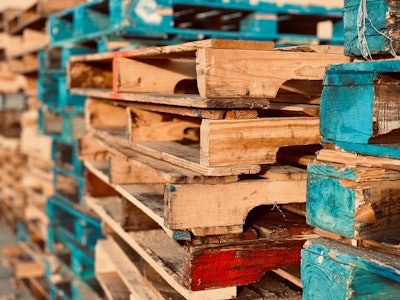
Here’s the scenario: You are responsible for pallets and have facilities across the United States. A major rail maintenance project begins buying rail-ties, which causes Georgia hardwood prices to skyrocket. The White House hits Canada with a punitive tariff on softwood, slowing the flow of lumber to a trickle. The Coronavirus disease (COVID-19) reaches the rolling hills outside of Philadelphia and the mills are shut down left and right. And, an earthquake in Chile disrupts global pulp supply, which kicks all latent U.S. pulp production capacity into high gear, causing industrial-grade lumber in east Texas to disappear. These are all things that could – and have – happened.
As the pallet buyer, are you ready for all of this? You haven’t been purchasing solely based on price, but rather on agility and resiliency, right? You have a backup plan in place, right? Of course, you don’t actually have a strategy when it comes to pallet procurement, so the answer is, “No, there is no plan!”
Agility and resiliency are two main factors that help prepare for disruption. But, here's how to begin thinking about working these ideas into your pallet supply.
Step 1 sounds far too simple, but is the most common hurdle for pallet users. You must have accurate specifications for your pallets. Most organizations either lack specs altogether, or have inaccurate information from outdated designs that prohibit competitors from getting a fair shake at quoting on the true product. Sometimes the current supplier places subtle features in the specs that they don’t actually provide, which increases the cost to build, thus making outside competition appear to be unreasonably expensive.
Instead, pallet specs should clearly outline all dimensions of the pallets and their components. They should specify wood species groups, such as dense hardwood, spruce/pine/fir (SPF), green pine, etc. They should also use standard components by region. For instance, board widths should be based on standard 5.5 inches and 3.5 inches to prevent suppliers from weaponizing odd cuts that only they have access to. The best pallet mills are almost always busy, so if you have incomplete specs or specs laced with quoting traps, most of these will pass. They’ll have customers bringing them work that is clearly defined and much easier to convert into long term business.
Step 2 is to diversify the supplier base and develop relationships with multiple pallet yards. If you are a manufacturer and use 20,000 pallets a year or more at an individual site, you should be able to split the volume 50/50 or 60/40 among two different mills. You want two different physical yards with two different owners. This protects against fire, bankruptcy and pricing policy. You also want these two different suppliers to be in two different markets or geographies. An added benefit is to be able to compare the pricing actions of one to the other. Ask both for feedback about the pallet/lumber market and see if the answers make sense.
If you get this far, you will have a decent foundation in place. You have added agility and resiliency. The next steps further this effort by creating options and increasing the speed at which to deploy. These are more advanced than the previous foundational steps. These require an in-depth knowledge of pallets and the manufacturing process, but are well worth the additional effort.
Standardization allows you to simplify supply and support one geography from another. Take a client that uses 48x48 pallets in multiple locations on the East Coast, for example. Over the years, these pallets have been standardized and run on all the machines in all the different manufacturing plants. So, if there is a breakdown of supply in Philadelphia, pallet stock in Atlanta can be shipped north to quell the emergency. The option to supply individual plants by diverting the supply of sister locations increases your resiliency.
Finally, gain a solid functional understanding of how your pallets work within your system. This means understanding why your pallets are designed the way they are, how they interact with your product and how they engage the machines in your system. This knowledge allows you to change designs, wood species or even transition to remanufactured pallets on the fly without having to assemble a committee of people across different sites to figure out if the changes will work. During times of market disruption, all of the pallet users are looking for roughly the same thing at the same time. You need to get there first. You need to lock down the capacity and materials first. To do this, you have to be decisive. This is also essential to spot and capture the big opportunities you can’t find by quoting.
So, just ask, when was the last time you quoted your pallet spend? Were you able to organize it all in a day or two? Did you know who to reach out to? Were the results clear cut, and did they lead to quick and confident decisions? Were the savings ever realized and long lived? Now imagine trying to do the same thing during times of market turbulence. Take time to mitigate the risk of your pallet supply by incorporating strategies to be more resilient and agile. This will often lead to pallet savings too.



















